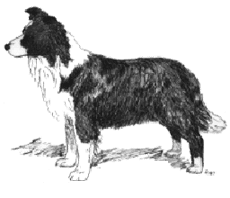Border Collie
A breed standard is the guideline which describes the ideal characteristics, temperament, and appearance of a breed and ensures that the breed is fit for function with soundness essential. Breeders and judges should at all times be careful to avoid obvious conditions and exaggerations, as well as being mindful of features which could be detrimental in any way to the health, welfare or soundness of this breed.
Breed Standard - Border Collie
 General Appearance:
General Appearance: The general appearance shall be that of a well proportioned dog, the smooth outline showing quality, gracefulness and perfect balance, combined with sufficient substance to ensure that it is capable of enduring long periods of active duty in its intended task as a working sheep dog. Any tendency to coarseness or weediness is undesirable.
Characteristics: The Border Collie is highly intelligent, with an instinctive tendency to work and is readily responsive to training. Its keen, alert and eager expression add to its intelligent appearance, whilst its loyal and faithful nature demonstrates that it is at all times kindly disposed towards stock. Any aspect of structure or temperament foreign to a working dog is uncharacteristic.
Temperament: (See under Characteristics)
Head: The skull is broad and flat between the ears, slightly narrowing to the eye, with a pronounced stop, cheeks deep but not prominent. The muzzle tapering to the nose, is strong and the same length as the skull. The lips are tight and clean and the nose is large with open nostrils. The nose colour in all dogs will be a solid colour with no pink or light pigment, and shall complement the background colour of the dog.
Eyes: The eyes are set wide apart, oval shaped of moderate size harmonising with the colour of the coat but darker colour preferred, except in the case of chocolate where a lighter colour is permissible and in the case of merles where blue is permissible. The expression is mild but keen, alert and intelligent.
Ears: The ears should be of medium size and texture, set well apart, carried semi:erect. They are sensitive in their use, and inside well furnished with hair.
Mouth: The teeth should be sound, strong and evenly spaced, the lower incisors just behind but touching the upper, that is a scissor bite.
Neck: The neck is of good length, strong and muscular, slightly arched and broadening to the shoulders, without throatiness or coarseness.
Forequarters: The shoulders are long, and well angulated to the upper arm, neither in nor out at elbow. The forelegs are well boned, straight and parallel when viewed from the front. Pasterns show flexibility with a slight slope when viewed from the side.
Body: The body is moderately long with well sprung ribs tapering to a fairly deep and moderately broad chest. The loins are broad, deep, muscular and only slightly arched, flanks deep and not cut up.
Hindquarters: The hindquarters are broad and muscular, in profile sloping gracefully to the set on of tail. The thighs are long, broad, deep and muscular with well turned stifles and strong hocks, well let down, and when viewed from the rear are straight and parallel.
Feet: Oval in shape, pads deep, strong and sound, toes moderately arched and close together. Nails short and strong.
Tail: The tail is moderately long, set on low, well furnished and with an upward swirl towards the end, completing the graceful contour and balance of the dog. The tail may be raised in excitement, but not carried over the back.
Movement: The movement is free, smooth and tireless, with a minimum lift of the feet, conveying the impression of the ability to move with great stealth. The action, viewed from the front, should be straight forward and true, without weakness at shoulders, elbows or pasterns. Viewed from behind the quarters thrust with strength and flexibility, with hocks not close nor too far apart. When trotting, the dog’s feet tend to come closer together as speed increases, but when the dog comes to rest he should stand four square. Any tendency to stiltiness or to cowhocks or bowhocks is a serious fault.
Coat: Double coated, with a moderately long, dense, medium textured topcoat while the undercoat is short, soft and dense, making a weather resisting protection, with abundant coat to form mane, breeching and brush. On face, ear tips, forelegs (except for feather), hind legs from hock to ground, the hair is short and smooth. A smooth coat is acceptable.
Colour: A variety of colours is permissible, but white should never predominate.
Size: Height - Dogs 48:53 cm (approx. 19:21 ins) at withers. Bitches 46:51 cm (approx. 18:20 ins) at withers.
Faults: Any departure from the foregoing points should be considered a fault and the seriousness with which the fault should be regarded should be in exact proportion to its degree.
Note: Male animals should have two apparently normal testicles fully descended into the scrotum.
DNZ No 516
Copyright Dogs New Zealand
01 Mar 2005
Any departure from the foregoing points should be considered a fault and the seriousness with which the fault should be regarded should be in exact proportion to its degree and its effect upon the health and welfare of the dog and on the dog’s ability to perform its traditional work.




